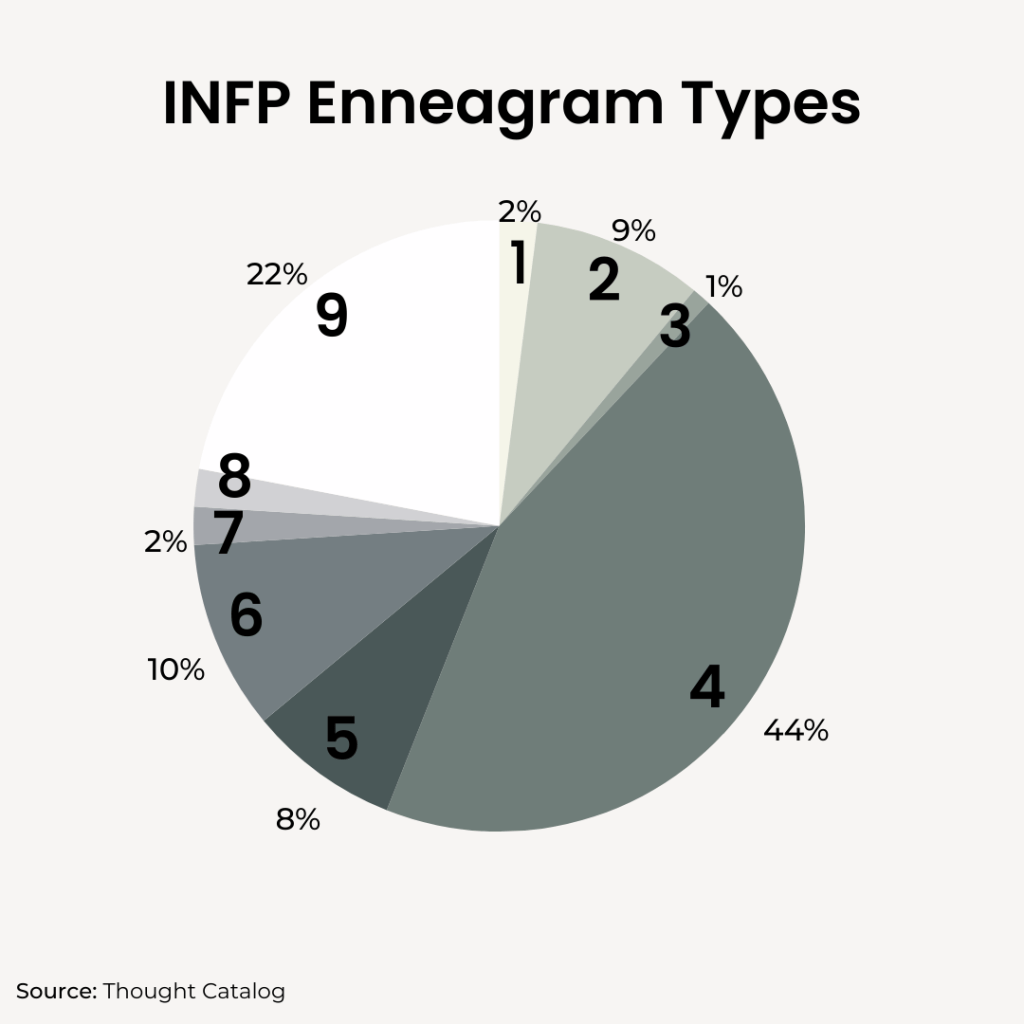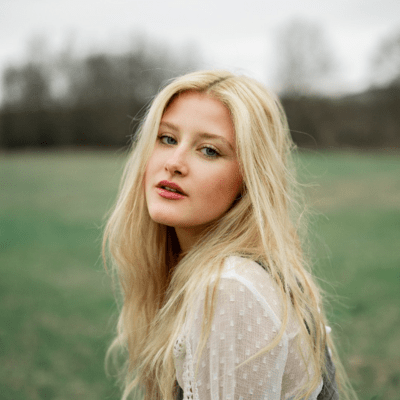How INFP Enneagram Types Differ
If you’ve found this blog post, you probably already know which of the 16 personality types you are. But do you know your Enneagram type? If not, you should definitely check it out – there’s a lot of valuable information to be gleaned from this personality theory.

If you’ve found this blog post, you probably already know which of the 16 personality types you are. But do you know your Enneagram type? If not, you should definitely check it out – there’s a lot of valuable information to be gleaned from this personality theory.
But even if you’re already familiar with the Enneagram, did you know that there’s a correlation between the 16 personality types and Enneagram?
While the 16 personalities model is more focused on how we interact with the world around us, the Enneagram framework delves deeper into our underlying motivations and basic fears.
So when you combine your 16 personalities type and your Enneagram type, you can get some even deeper insights into why you make decisions the way that you do or why you behave in certain ways.
Today, we’re going to take a look at how INFPs relate to each of the nine Enneagram types. Keep reading for insights and tips on how to better understand yourself and others.
Which Enneagram types are most common among INFPs?
According to a study conducted by Thought Catalog, the most common Enneagram type for INFPs is Enneagram 4. This isn’t too surprising. Enneagram 4s are creative, sensitive, and introspective. They’re also deeply emotional and can be quite idealistic. These are the kind of INFPs who are individualistic and often feel misunderstood.

The joint second most common Enneagram type for INFPs is Enneagram 9. This makes a lot of sense when you consider that INFPs strongly value peace and harmony. They’re gentle, easy-going, and accepting of others. These are the kind of INFPs who are always looking to make everyone happy and comfortable.
Anyway, let’s save some thoughts for later on in the post.
How each Enneagram type manifests in INFPs
Let’s now take a look at how INFPs differ depending on their Enneagram type.
INFP Enneagram 1
INFPs who identify as Enneagram 1 tend to be more of a perfectionist than your typical INFP. They’re adaptable and calm, but they also have a strong sense of right and wrong. In addition, they are more considerate, and they tend to think through decisions carefully.
INFP Enneagram 1s are always striving for the best, and they have an innate desire to live up to their own standards. They have a stronger work ethic than your typical INFP, and they tend to be able to concentrate for longer periods of time. In addition, they are more conscientious, and they want to be seen as ‘good’ people.
People of this type have a strong sense of morality and justice, which shines through in their words and actions. However, INFP Enneagram 1s are quite hard on themselves and can often benefit from learning to let go of their perfectionist tendencies.
INFP Enneagram 2

INFPs who identify as Enneagram 2 are more people-oriented and come across as more agreeable than your typical INFP. While most INFPs are flexible and easy-going, they can be quite headstrong at times.
INFP Enneagram 2s tend to focus more on other people’s needs. They’re always looking out for their loved ones and quick to lend a helping hand. They are warm and nurturing. In addition, they have a deep understanding of human nature, which enables them to ensure that people around them are happy and comfortable. This comes from a place of genuinely wanting to help people.
Some INFPs struggle to follow through on their word because they can be disorganized and make plans that they don’t end up sticking to. This doesn’t tend to be the case with INFP Enneagram 2s, though, because they want to be someone who can be counted on. However, INFP Enneagram 2s can use their people skills to manipulate others into doing what they want.
INFP Enneagram 3
INFPs who identify as Enneagram 3 are more driven and ambitious than your typical INFP. They’re always striving to be the best, and they tend to be competitive, which isn’t a trait you usually see in INFPs. INFP Enneagram 3s tend to be more comfortable in social situations than your typical INFP. They’re the kind of people who can be very convincing when they want to be. It’s worth noting that this is a very rare Enneagram type for INFPs.
INFP Enneagram 3s are resourceful, and they’re always looking for ways to improve. They’re never satisfied with mediocrity, and they push themselves to their limits. In addition, they are focused on achieving success. They are more comfortable in leadership roles, and they are often very visionary. They can find it hard to sit still, which is why they like to be doing things.
People of this type are highly intuitive and they are good at reading between the lines. They use these skills to pick up on social dynamics, and they can be very persuasive. In addition, they are highly aware of people’s perceptions of them. This means that they can be quite image-conscious and concerned about what others think of them.
INFP Enneagram 4
This is the most common Enneagram type for an INFP. INFPs are emotional people, and they naturally take time to self-reflect; INFP Enneagram 4s are even more introspective and sensitive than your typical INFP. They are highly self-aware and in touch with their emotions. In addition, they tend to need more alone time than some other INFPs.
While most INFPs are happy to spend time alone and match to the beat of their own drum, you see these traits accentuated in INFP Enneagram 4s. They can feel misunderstood, and they sometimes live with a sense of being ‘different’. In addition, they have a deep desire for self-expression and are often drawn to the arts. This ties in with the fact that they are some of the most creative INFPs.
INFP Enneagram 4s tend to be more individualistic, often through their fashion sense, although this isn’t exclusively related to being an INFP Enneagram 4. People of this type often have a deep understanding of human nature, and they can be very perceptive when it comes to other people’s emotions. However, their heightened awareness of their own emotions can make them susceptible to depression and anxiety.
INFP Enneagram 5
INFP Enneagram 5s tend to be more cerebral than your typical INFP. They’re highly intelligent, and they love to learn new things. In addition, they tend to make more calculated decisions, and they don’t have that unpredictable streak that can be seen in some INFPs.
People of this type are also quite independent and self-sufficient. In fact, INFP Enneagram 5s tend to be highly independent, and they become drained quickly from socializing. Like INFP Enneagram 4s, they need more alone time so that they can think and process information. This type is often very resourceful, and they’re great at coming up with creative solutions.

While INFPs tend to be creative and self-expressive, INFPs Enneagram 5s are also talented at analyzing information and data. In addition, they’re quick to notice inconsistencies in their environment that others might miss. However, they can be arrogant and condescending when they think they are right.
INFP Enneagram 6
INFP Enneagram 6s tend to be more anxious and uncertain than your typical INFP. While most INFPs like to experiment and aren’t afraid to take a chance, INFP Enneagram 6s are more risk-averse. They take a cautious approach to life, and they spend time thinking through decisions.
INFP Enneagram 6s are very loyal and protective of their loved ones. They’re the kind of people who would do anything for their family and friends. In fact, people of this type value loyalty above all else. While some INFPs can be a little flighty, INFP Enneagram 6s take pride in sticking to their word. You can count on them to follow through. They value being part of a group, and they often have a strong sense of community.
People of this type like to plan for multiple scenarios because they are focused on safety and security. Fortunately, they have a natural ability to imagine different ways a situation might play in the future. However, they can need reassurance from others at times. They can also be prone to paranoia and worry. This means that they can be quite pessimistic.
INFP Enneagram 7
This is a rare Enneagram type for INFPs. INFP Enneagram 7s are fun-loving and spontaneous. They’re always looking for new experiences. Despite being introverts, they enjoy exploring, and they often shy away from routine. Ultimately, they need to be kept on their toes because they don’t cope well with boredom.
People of this type seek out adventure and stimulation. In addition, they aren’t afraid to break rules and push boundaries. They take the view that it’s worth taking risks for new experiences. However, their spontaneity can cross over into the territory of being impulsive, which can sometimes get them into trouble.
INFP Enneagram 7s often have a scattered thought process. They’re always thinking about the next thing, and they can find it hard to focus on one task for too long. This can make them seem a little disorganized, and their impulsivity can mean that they don’t always stick to plans. It’s not unusual for INFP Enneagram 7s to change tack at a moment’s notice.
INFP Enneagram 8

This is another rare Enneagram type for INFPs. INFP Enneagram 8s are more ambitious and competitive. They are also more assertive and can be direct. In addition, they are goal-oriented. As a result, they have a tougher edge than some other INFPs, and they are often seen as headstrong, but in an understated and calm way.
INFP Enneagram 8s are more comfortable in leadership positions. They tend to appreciate flat hierarchical structures, where everybody can have their say, and they don’t tend to be overly controlling. INFP micromanagers are a rare breed. While most INFPs are resourceful, INFP Enneagram 8s are especially so.
However, their competitive nature can sometimes make them seem arrogant, and they can have a hard time losing. In addition, their impulsivity can lead them to make rash decisions. But INFP Enneagram 8s are also quick-thinkers, and they’re very good at problem-solving on the fly.
INFP Enneagram 9
This is the second most common Enneagram type for INFPs. INFP Enneagram 9s are even more easy-going and agreeable than your typical INFP. They’re peacemakers who strive to maintain harmony. In addition, they’re usually quite content with letting others take the lead.
People of this type tend to be more patient and willing to compromise. While most INFPs are adaptable, INFP Enneagram 9s tend to be the most adaptable of all the INFP Enneagram types. At the same time as being flexible, INFPs can actually be resistant to change because they can view it as a disruption to harmony.
INFPs tend to be calm and collected in general, and these traits are even more evident in INFP Enneagram 9s. They are highly talented at reading people, and they use these skills to mediate conflict when necessary. Ultimately, they like to maintain a sense of peace. As a result, they can even be more conflict-averse than other INFPs.
Nuances between INFP Enneagram types
So there you have it, the nuances between INFPs of different Enneagram types. While we have focused on the differences in this post, it’s important to remember that you’re still an INFP first and foremost.
This means that you like your alone time and you have a strong sense of morality. There’s a good chance that you’ll also be imaginative, emotional, and open-minded. However, your exact Enneagram type will play a role in how specific traits are expressed.
Particularly if you’re one of the less common INFP Enneagram types, we hope this post has provided insight into why you might not fit the stereotype of an INFP.
Final thoughts on INFP Enneagram types
If you enjoyed this post, you might also like How ENFP Enneagram Types Differ. Finally, if you liked this post, share it with friends so they can better understand the differences between the INFP Enneagram types.




